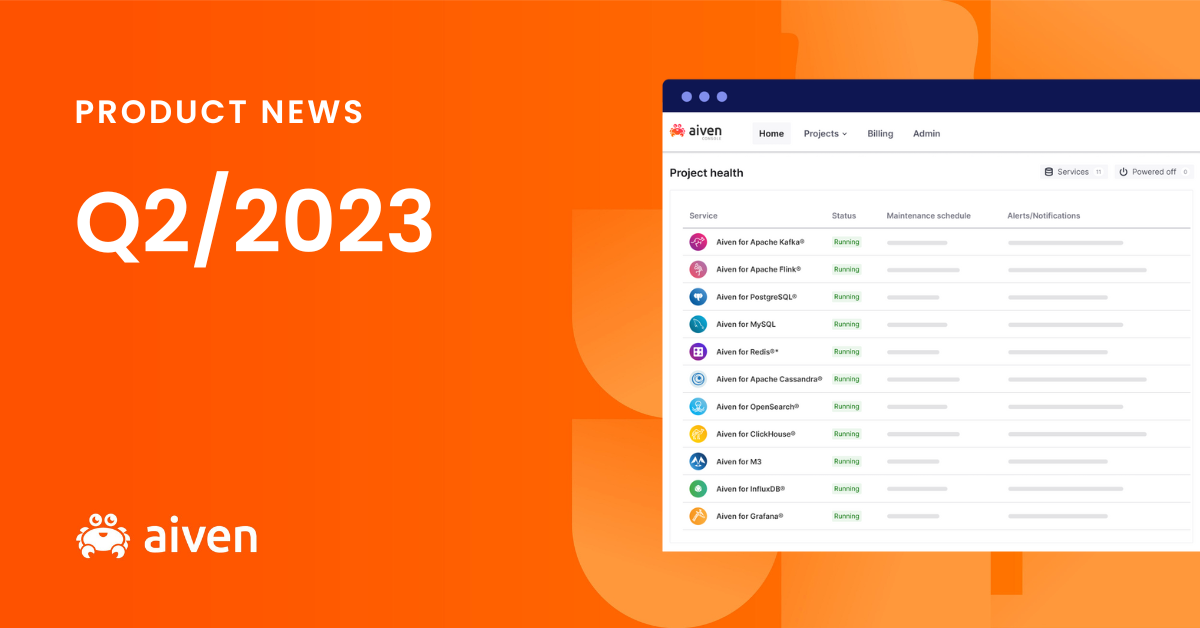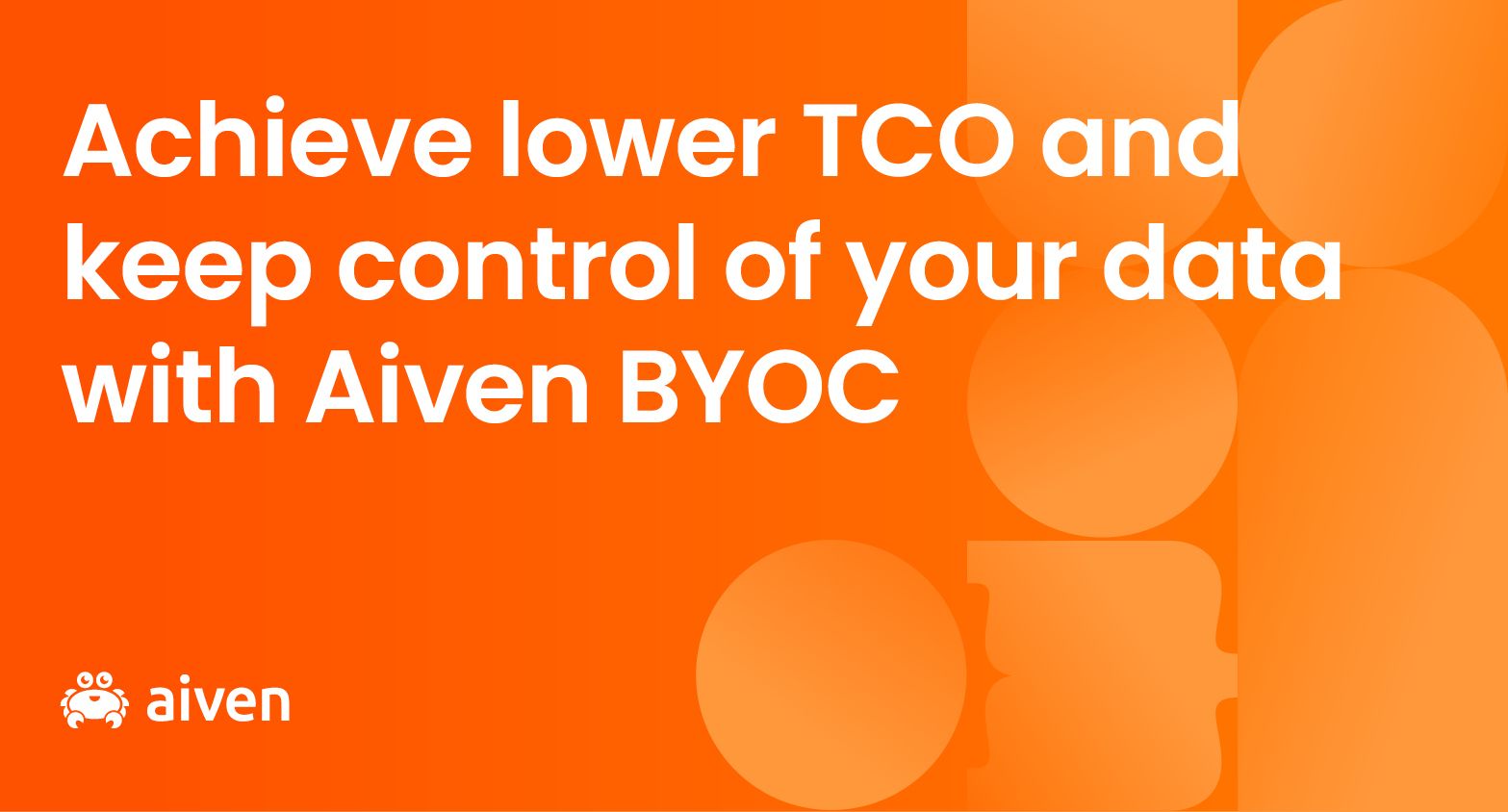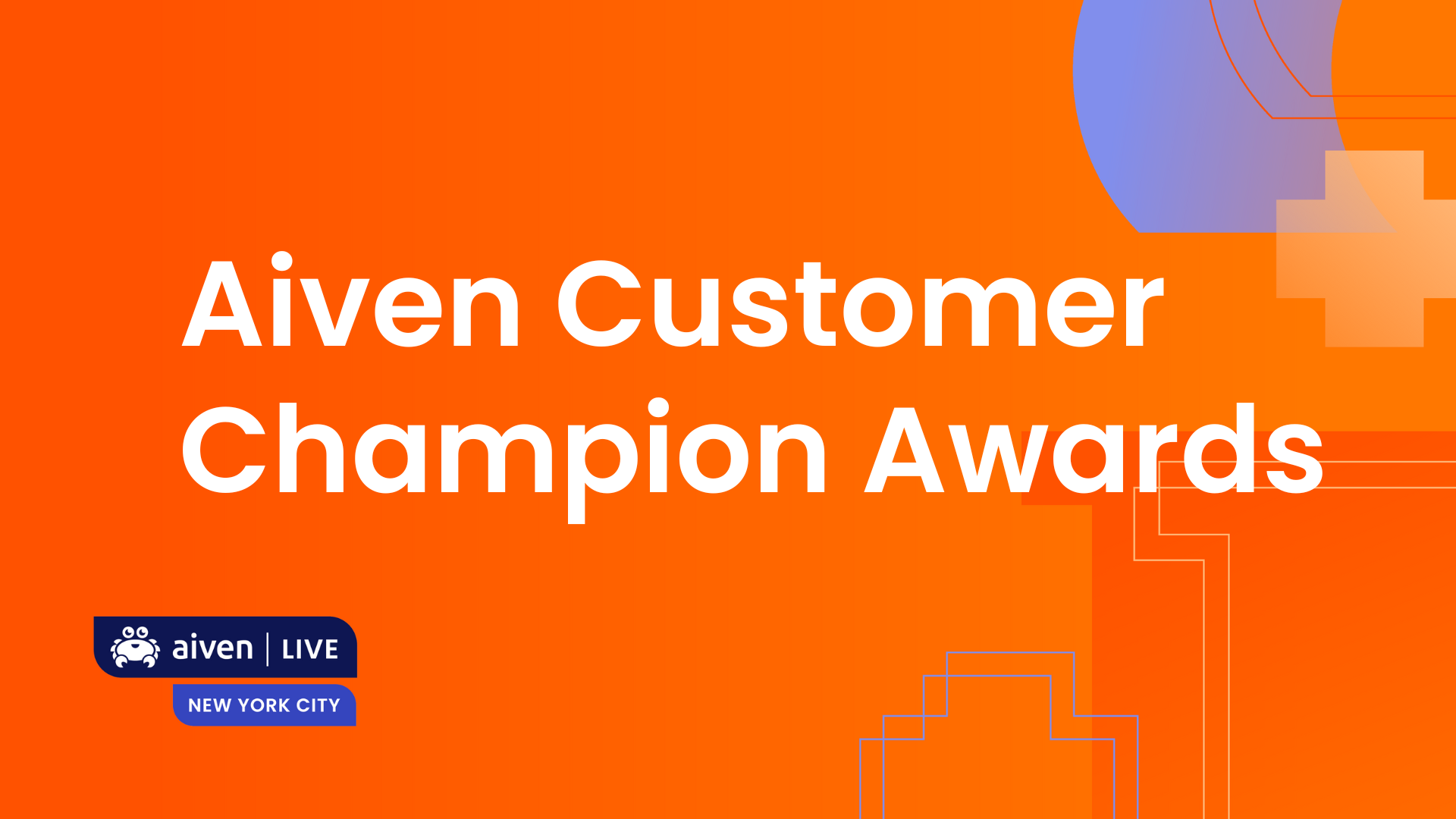Mar 5, 2024
Navigating the data maze: 5 essential questions to guide your tool selection
Unraveling the complexities of handling data to match your tech needs
Jenn Junod
|RSS FeedDeveloper Advocate at Aiven
Today, we're embarking on an adventure through the intricate world of data. Whether you're a seasoned CTO or new to tech overall, understanding the nuances of data is critical to making informed decisions. Let's unravel this complex data web, asking the right questions to discover the perfect tools for your data journey.
What's the shape of your data?
No two datasets are alike. The structure of the data changes the kind of tooling needed to manipulate that data
Structured or unstructured?
From a structural perspective you can think of data as existing on a continuum or gradient: on the one side, there's highly structured data, like customer profiles. Each customer has a known name, address, phone number, and we can expect those to fall within certain formatting constraints. For example, a phone number will always be a set of numbers and special characters. On the other side, there's unstructured data: the contents of an email, for example, are unstructured.
The shape of the data should define what kind of software you use to store and manipulate it.
- Structured data: Structured data is data where you have predictable fields with predictable data types. Storing a customer profile is the perfect example: customers have a name, phone number and email address. You know that the name will be a String, you know the phone number will be numbers, and you know the email address will follow a certain format. You might need to access these individual pieces of data on their own, or you might need to bring up a Name-Phone-Email set to generate a display.
- Possible tech match: Relational (SQL) databases are well suited for structured data because they store data in columns and rows. They also provide good validation at the database level for the kinds of data coming in. Tools like MySQL or PostgreSQL® work efficiently for storing and querying structured data.
- Semi-structured data: Semi-structured data is data that contains some structure, such as tags or identifiers, but does not or cannot be stored in a strictly tabular fashion. For example, comments on a Google Doc are semi-structured data: there are certain pieces of the data that are known and consistent (the comment author's name and email, for example), and pieces of the data that are free-form (the comment itself). As mentioned above, it's usually best to store data in the most structured format possible, as that lets you validate and manipulate the data more efficiently. Look for a tabular database with support for data formats like JSON and XML.
- Possible tech match: JSON or XML databases, which contain structured elements but are more flexible than traditional databases. Additional options include MongoDB or PostgreSQL which has extensive support for JSON.
- Unstructured data: This is data that is unique in each instance, but has little to no identifiable, consistent internal fields. Email is a great example of unstructured data. While you can count on an email having a sender and a receiver, you can't predict whether or not it will have an attached file, whether or not anyone will be included in the CC and BCC lines, or what kind of text (if any) will be included in the body.
- Possible tech match: NoSQL databases like Cassandra or Redis, document stores, or data lakes can handle unstructured data effectively.
Manipulation needs
The next thing to consider is what you intend to do with your data. Are you collecting data for long term storage or are you moving data from one location to another, analyzing and using it contextually? In the world of data systems, we think of this data as either being static, dynamic, or a hybrid of the both.
Not all data services are oriented towards storage alone. Streaming messaging services, on-the-fly data analysis and storage for large aggregates of analytics data are all valid use cases
- Static data: Data that does not often need updates and can maintain stability and allow querying over time and possibly massive amounts of data.
- Possible tech match: Relational databases like MySQL or PostgreSQL are suitable for static data as they maintain data integrity and stability over time. ClickHouse is on the rise since it supports analytical workloads over massive amounts of data.
- Dynamic data: Constantly evolving data that frequently updates in real-time. Think stock prices or sensor data like your thermostat changing automatically when it gets too cold.
- Possible tech match: Technologies like Apache Kafka® for real-time data streaming or in-memory databases like Redis®* for rapid data access are well-suited for dynamic data.
- Hybrid Data: Data that occasionally changes, like monthly sales records or quarterly performance data. Here, it would help if you had a balance between tools that handle some dynamic updates and those that maintain static information.
- Possible tech match: Hybrid data scenarios benefit from a combination of technologies. You can use a combination of traditional databases like PostgreSQL and data streaming platforms like Kafka for hybrid data needs.
How will you use and access your data?
Now that you’ve looked at the structure and use of your data, how and who will be accessing the data? The speed and frequency with which you need access to data determines the tools that are viable for you. In this section we’ll review different ways of accessing your data from periodically needing to receive updates to needing those updates in real time.
Data access patterns
- Pull data for reports (periodic access): Data that is accessed occasionally, in batches. Requests are made at infrequent intervals and need to wait for the report or similar to compile.
- Possible tech match: SQL Databases are ideal for scenarios requiring detailed, complex queries. PostgreSQL or MySQL (and ClickHouse) are well-suited for environments where data integrity and periodic access are the norm. Specialized datastores like OpenSearch can be a good hit for particular search patterns (which involve text search).
Real-Time Analytics (Continuous Access): Like mentioned above, in Dynamic Data, Constantly evolving data that frequently updates in real-time. The information flows continuously. - Possible tech match: Using Streaming Technologies. Platforms like Apache Kafka® or Apache Flink® are the champions of high-speed, real-time data processing. They're great for scenarios demanding immediate insights and continuous data flow.
- Possible tech match: SQL Databases are ideal for scenarios requiring detailed, complex queries. PostgreSQL or MySQL (and ClickHouse) are well-suited for environments where data integrity and periodic access are the norm. Specialized datastores like OpenSearch can be a good hit for particular search patterns (which involve text search).
- Hybrid access: A combination of pull and stream methods for scenarios where you need regular reports but also require real-time alerts or updates.
- Possible tech match: Hybrid Database Systems: These systems combine the features of both SQL and NoSQL databases, offering flexibility for varied data access patterns and complex queries. They are ideal for organizations with diverse data needs. A few possibilities could look like DynamoDB, Altibase, or Microsoft SQL Server.
What are your security and privacy requirements?
When thinking of Security and Privacy Requirements, what does your industry and data require? Understanding the compliance and safety needs of your data will guide you to what tools can meet those requirements.
Navigating regulatory compliance
- Understanding the requirements of your data: Key items that you would need to identify would include, Users, Roles, Access Patterns, and how strict the assets definition would be.
- Possible tech match: Modern databases offer ways to perform "raw level security" enabling you to define exactly what a certain user can or cannot see.
- Key regulations: GDPR in the EU, HIPAA for healthcare data in the US, and PCI DSS for credit card transactions are just a few examples. Each set of regulations requires specific handling and protection measures for personal and sensitive data.
- Possible tech match: Data Privacy Management Platforms. Tools like OneTrust or TrustArc provide comprehensive solutions for managing privacy compliance, including GDPR.
- Industry-specific regulations: Apart from GDPR, HIPAA, and PCI DSS, certain industries have specific data handling regulations. For example, FERPA for educational data in the US.
- Possible tech match: Healthcare Data Management Systems and Payment Processing Platforms. Healthcare-specific systems like Epic Systems or Cerner Corporation help healthcare organizations meet HIPAA requirements. PCI DSS-compliant payment gateways such as Stripe or Braintree can be used for secure credit card transactions.
Ensuring minimal data exposure
- Implementing robust access control: Use principles like Least Privilege and Role-Based Access Control to ensure each user accesses only what they need, no more.
- Possible tech match: PostgreSQL, MySQL, Kafka, are a few options that provide ways to safely dictate what users are and what they can do. Tools like Klaw, port the user and role definition to match internal processes.
- Data masking and encryption: Keep sensitive information hidden and secure at rest and in transit.
- Possible tech match: Data Masking and Encryption Tools. Utilize database encryption solutions like Amazon RDS encryption or file-level encryption tools like VeraCrypt. Aiven for PostgreSQL and Aiven for Flink can be used to mask, obscure and aggregate data
How much data do you have, and what is it's growth trajectory?
When thinking about the amount of data and how the data will expand, it is vital to consider long term storage of your data, how quickly data can be accessed, and how your data will grow over time.
Understanding your data's volume
- Small to large scale: It's essential to choose tools and strategies to handle this growth, from gigabytes in a local database to petabytes in cloud-based, distributed systems.
- Possible tech match: Data tools like PostgreSQL and Kafka are often used for scalability. Especially moving to different tiers of storage needed like Kafka Tiered Storage. Data can also be parked in a data lake or Cloud-based, distributed systems like Amazon S3, Google Cloud Storage, or Azure Blob Storage are suitable for handling data that starts small and can grow to petabytes. Using one of these options can allow the data to be queried by tools such as Clickhouse. Platforms such as Aiven can assist with scaling on cloud storage.
- Data complexity: In addition to volume, consider the complexity of your data. Complex data might require more advanced processing tools, even if the volume could be a lot higher.
- Possible tech match: Advanced data processing tools like Apache Flink, Apache Spark™, or Apache Hadoop® can handle complex data structures and analytics, regardless of the volume.
Planning for future growth
- Scalability strategies: Whether vertical scaling (enhancing existing systems) or horizontal scaling (expanding to multiple systems), your approach should be flexible and scalable.
- Possible tech match: You may find that you need more than one tool to fit the solution for what you need to scale. An option for vertical scaling (enhancing existing systems) could be PostgreSQL and options for horizontal scaling (expanding to multiple systems) could be Cassandra, Kafka, Flink, and Clickhouse.
- Choosing the right technologies: Evaluate the balance between serverless and traditional offering. Look for cloud solutions that provide the type of elasticity you require. Might it be vertical or horizontal scaling, serverless or easily scalable instances
- Possible tech match: Cloud solutions like AWS, Google Cloud, or Azure offer elasticity and scalability. Additionally, consider NoSQL databases like Apache Cassandra® or distributed databases like Amazon DynamoDB for handling distributed data. There are many different avenues that one could go. Serverless may be less expensive initially but as it scales with traffic become exponentially more costly. Another tool you could consider would be Aiven. The Aiven platform provides you a scalable way to keep your bill under control.
- Data lifecycle management: As your data grows, consider implementing data lifecycle management strategies to archive older data, keeping your active datasets efficient and manageable.
- Possible tech match: You can Implement data lifecycle management strategies moving data from operational databases like PostgreSQL and MySQL to analytical databases like Clickhouse that can scale horizontally.
Are you keeping up with emerging trends and technologies?
It’s now time to consider how your data will morph over time and how to keep up with the emerging trends. A big factor to consider, how future proof is the infrastructure of the data. By being aware of emerging trends, you will be able to decipher if new tools will help with engineering power, storage needs, and cost optimization.
Exploring cutting-edge technologies
- Real-time processing: Technologies like Apache Kafka are revolutionizing how we handle data, offering immediate processing and distribution capabilities.
- Possible tech match: Apache Kafka and Apache Flink for real-time data streaming and processing. It enables rapid data processing and distribution, making it ideal for real-time analytics and event-driven applications.
- Big data and AI integration: AI and machine learning tools are opening new frontiers in data analytics and automation.
- Possible tech match: Hadoop and Spark for handling large-scale data analytics and AI integration. Additionally, consider machine learning frameworks like TensorFlow or PyTorch for advanced AI capabilities. Keep an eye on existing technologies as they add AI capabilities, such as PostgreSQL with pgvector, OpenSearch and ClickHouse.
- Cloud computing advancements: Keep an eye on the latest in cloud computing, like serverless architectures and edge computing, which can significantly impact data processing and storage strategies.
- Possible tech match: Explore cloud computing advancements such as serverless architectures (for instance., AWS Lambda, Azure Functions) for cost-effective and scalable computing. The article “Real-Time Sentiment Analysis Using Apache Kafka and SageMaker Jupyter Notebooks” would be a good starting point to understanding the process.
Balancing stability with innovation
- Hybrid approaches: The key is to blend the reliability of traditional databases with the agility of new technologies. This creates a versatile, robust system that can handle various data scenarios.
- Possible tech match: Implement hybrid database systems like Aiven for PostgreSQL to blend the reliability of traditional databases with the flexibility of new technologies. Utilize Kubernetes for container orchestration to create a versatile and adaptable system.
- Staying informed and adaptable: The tech landscape is ever-changing. Keeping abreast of new developments and being ready to incorporate them into your existing systems is crucial for staying ahead
- Possible tech match: Stay informed about emerging technologies through industry-specific publications, forums, and conferences. Adopt DevOps practices and continuous integration/deployment (CI/CD) pipelines to ensure your systems remain adaptable to new developments.
- Environmental considerations: As you adopt new technologies, consider their environmental impact. Energy-efficient data centers and green computing practices are becoming increasingly important in the tech world.
- Possible tech match: Implement energy-efficient data center practices using technologies like server consolidation, virtualization, and data center cooling optimizations. Consider cloud providers focusing on sustainability, such as AWS's commitment to renewable energy.
Learn more
In this labyrinth of data management, understanding these five key aspects is like having a map and compass. It's about knowing where you are, where you're heading, and having the right tools for the journey. Each question we've explored is a stepping stone towards more informed, efficient, and secure data handling.
So what's your data story? Are you quickly navigating this maze's twists and turns or seeking a guiding light? Share your tales, questions, and insights below. Let's continue this conversation and grow together in this ever-changing realm of data.
Remember, we're here to guide you in this complex dance of data handling. For more insights and updates, follow us on YouTube, LinkedIn, and X.
Further reading
Table of contents
- What's the shape of your data?
- Structured or unstructured?
- Manipulation needs
- How will you use and access your data?
- Data access patterns
- What are your security and privacy requirements?
- Navigating regulatory compliance
- Ensuring minimal data exposure
- How much data do you have, and what is it's growth trajectory?
- Understanding your data's volume
- Planning for future growth
- Are you keeping up with emerging trends and technologies?
- Exploring cutting-edge technologies
- Balancing stability with innovation
- Learn more
- Further reading
Stay updated with Aiven
Subscribe for the latest news and insights on open source, Aiven offerings, and more.



